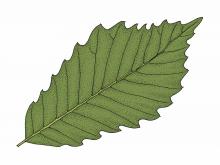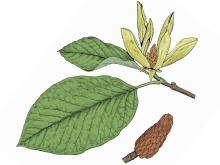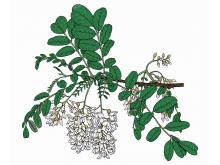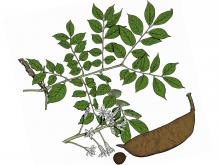Trees, Shrubs and Woody Vines
Media

Species Types
Scientific Name
Quercus muehlenbergii
Description
Chinkapin oak is fairly easy to identify because of its distinctively toothed leaves. Look for it growing in rocky soils derived from limestone or dolomite on bluffs and in upland woods, and in floodplain forests and lower slopes along streams.
Media

Species Types
Scientific Name
Magnolia acuminata
Description
Cucumber magnolia is an impressive, large, broad-spreading shade tree native to southern Missouri. It is often cultivated in the eastern United States because, compared to more southern magnolias, it is relatively cold-hardy.
Media

Species Types
Scientific Name
Robinia pseudoacacia
Description
Black locust, a member of the bean family, is easy to appreciate in May and June, when its showy white clusters of flowers perfume the breeze with their sweet smell. Bees like the flowers, too.
Media

Species Types
Scientific Name
Cladrastis kentukea
Description
Early Appalachian settlers gave yellowwood its name because the root bark produces a clear yellow dye. This slow-growing tree is popular statewide as a landscaping ornamental, but in the wild it is uncommon to endangered throughout its natural range.
Media

Species Types
Scientific Name
Gymnocladus dioicus
Description
There’s no mistaking Kentucky coffee tree when its large, tough seedpods are hanging from its limbs or dropping to the ground below. Unpopular as food with today’s wildlife, these seedpods might have fed mastodons and other large, extinct North American mammals.
Media

Species Types
Scientific Name
Prunus serotina
Description
Black cherry is prized for its high-quality wood. With its rich red color, it is easy to machine and holds its shape well. Eastern tent caterpillars like black cherry as well, spinning “tents” or bags on the branches for protection while they feed on the leaves.
Media

Species Types
Scientific Name
Tilia americana
Description
American basswood is a common shade tree planted in lawns, parks, and along city streets. Recognize it by its leaf shape and texture, and by the unusual strap-shaped, reduced leaf attached to the clusters of small flowers.
Media

Species Types
Scientific Name
Carya spp.
Description
Hickories are an important part of Missouri’s oak-hickory woodlands and forests. They have tremendous economic value, too. Learn about the nine species of hickory found in Missouri.
Media

Species Types
Scientific Name
Quercus spp.
Description
Oaks are the most important group of trees in Missouri, in both human and ecosystem value. They dominate most of the forests, woodlands, and savannas in the state. Learn more about our 22 species.
Media

Species Types
Scientific Name
Vaccinium arboreum
Description
Farkleberry, or sparkleberry, is a stiff-branched shrub or small crooked tree growing in loose thickets on rocky soils, mostly south of the Missouri River. A type of blueberry, its black fruits are edible but dry and mealy.
See Also
About Trees, Shrubs and Woody Vines in Missouri
There are no sharp dividing lines between trees, shrubs, and woody vines, or even between woody and nonwoody plants. “Wood” is a type of tissue made of cellulose and lignin that many plants develop as they mature — whether they are “woody” or not. Trees are woody plants over 13 feet tall with a single trunk. Shrubs are less than 13 feet tall, with multiple stems. Vines require support or else sprawl over the ground.





















